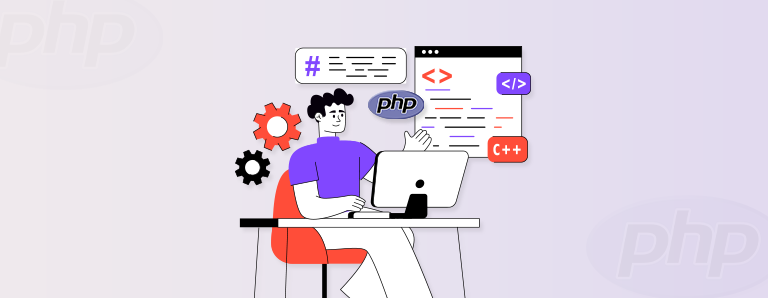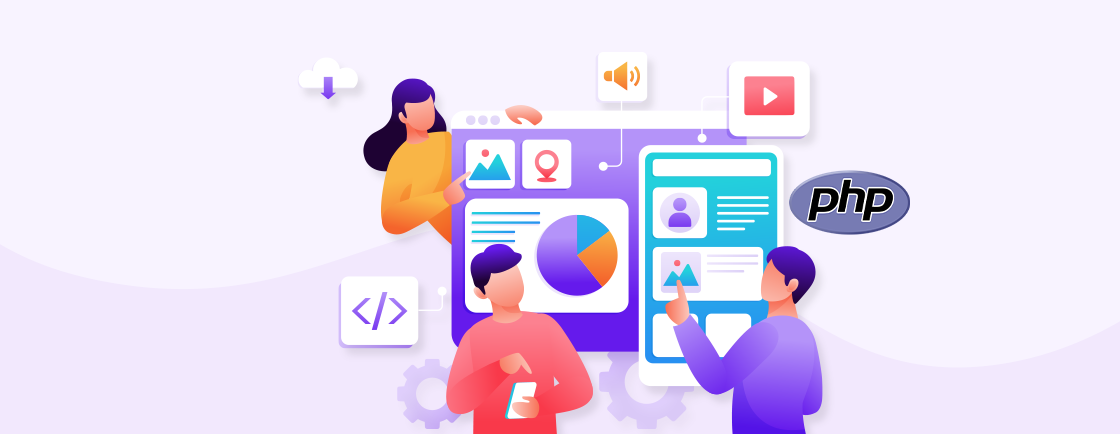Table of Contents
Fantasize building cloud-based applications without providing or maintaining servers. Sounds like a dream, right? That’s the magic of serverless architecture, and guess what? PHP adores playing in this sandbox too!
Serverless architecture slices PHP development into bite-sized, event-driven functions. Instead of managing servers, you focus on writing clean code that reacts to triggers like API calls or data changes. This pay-per-use model scales on demand, cutting operational costs and complexity.
In this blog, we’ll look at how do PHP and serverless architecture work together. So, let’s dive in!
What is Serverless Architecture?
Serverless Architecture offers a medium where you can build applications without the hassles of managing servers. No provisioning, no patching, just a straight focus on code. That’s the reality of serverless architecture, a revolutionary approach that’s transforming the software landscape.
Your application becomes a collection of independent functions, each triggered by specific events like API calls or data changes. These functions run on servers managed by the chosen cloud service provider, scaling up and down automatically based on demand.
- Scalability. Your application automatically adapts to traffic spikes and breaks. This ensures smooth performance without you lifting a finger.
- Faster Development. Put down the server setup and focus on writing code. Serverless lets you build and deploy applications in record time, leaving more time for what matters – innovation.
- Simplified Maintenance. Say goodbye to server maintenance headaches. Serverless takes care of everything under the hood, enabling you to concentrate on what you do best!
Serverless Architecture lets you build applications without managing servers, focusing purely on code while scaling automatically with demand. It speeds development and simplifies maintenance. Looking to leverage serverless PHP solutions? Hire dedicated PHP developers to build scalable, efficient, and maintenance-free applications tailored to your business needs.
How Do PHP and Serverless Architecture Work Together?
Forget the bulky LAMP stack; serverless architecture brings a refreshing twist to PHP development. It slices your PHP code into bite-sized, event-driven functions that run seamlessly in the cloud. Instead of wrestling with servers, you focus on modular code triggered by specific events like API calls or database changes.
- Reduced Operational Overhead. No more servers. Focus on your code creativity, while your cloud provider takes care of the server behind the scenes.
- Faster Development Cycles. Deploy and update your serverless PHP applications in a beat. Experiment, test, and release new features quickly, leaving your competitors in the dust.
- Microservices FTW. Break down applications into independent, easily maintainable microservices. This fuels agile development and a reliable architecture.
Ready to experience the magic of PHP and serverless architecture? Buckle up as we disclose how to get started now. You’ll learn how to choose the right cloud provider, set up your framework, and deploy your first serverless PHP application. Let’s unlock the full potential of this dynamic duo and take your applications to the next level!
How to Get Started With PHP Serverless Architecture?
All set to trade server hassles for cloud freedom? Let’s navigate the exciting world of getting started with PHP serverless architecture! Tighten your seat belts up as we chart a course through five key steps, from choosing your cloud provider to deploying your first application.
1. Choose Cloud Provider
Picking the right cloud provider is like choosing your ship for a grand serverless PHP adventure. It sets the course for your entire journey, so a well-informed decision is crucial.
- Know Your Needs. Assess your application’s complexity, expected traffic, and budget. Do you need extensive features or a simple, cost-effective platform? Matching your needs to the provider’s offerings optimizes your voyage.
- Consider the Anchors. Compare pricing models and free tiers. The cheapest option might not be the smoothest sail if it lacks crucial features or support.
- Language Support. Make sure your chosen provider offers robust PHP support. Look for tools, integrations, and documentation tailored to PHP serverless development.
- Community Currents. A vibrant community can be your lifeline in uncharted waters. Check for active forums, tutorials, and developer support.
- Explore the Open Seas. Don’t limit yourself to the biggest names. Investigate emerging providers offering niche benefits that align perfectly with your specific needs.
Remember, no single provider is the undisputed “king of the cloud.” Weigh your options, test offerings through trials, and choose the perfect fit for your PHP serverless adventure.
2. Select Serverless Framework
With your cloud provider chosen, it’s time to select your trusty ship – the serverless framework. This will carry your PHP code through the cloud seas. Don’t worry, we’ve got the compass to guide you through this critical decision!
- Know Shipmates. Consider your existing development team’s expertise and preferred tools. Some frameworks like Bref integrate seamlessly with Symfony, while OpenFaaS offers language-agnostic flexibility.
- Feature Focus. Each framework offers a unique toolkit. Align your framework’s features with your project’s specific needs and desired level of control.
- Deployment Ease. Some frameworks like Serverless Frameworks offer streamlined deployment processes with automated infrastructure management.
- Future Horizons. Consider your project’s growth potential. Choose a framework that actively updates, maintains backward compatibility, and boasts a roadmap that aligns with your long-term vision.
Choosing the right PHP framework is like picking the ideal rowboat for your adventure. Weigh your crew’s expertise and desired features. Top of all it should align with long-term goals to navigate you to success.
3. Install and Set Up the Chosen Framework
With your cloud companion and chosen PHP framework – it’s time to raise the anchor and set sail! This section includes the steps of installing and setting up your chosen serverless framework.
- Chart the Course. Follow the framework’s official documentation for detailed installation instructions. Each framework has its unique prerequisites and system requirements.
- Gather Provisions. Make sure you have the necessary dependencies like PHP installed and configured. Some frameworks might require additional tools or extensions, so double-check their documentation.
- Configure Connections. Establish communication between your local development environment and your chosen cloud provider. This typically involves setting up credentials and access keys within the framework configuration.
- Test the Waters. Run the framework’s built-in tests or deploy a simple “Hello World” function to verify everything is set up correctly.
4. Design Serverless PHP Application
With your framework prepped and provided, it’s time to draw the map for your grand serverless adventure! Let’s dive into the exciting domain of designing effective and scalable serverless PHP applications.
- Stateless Space. Remember, serverless functions are quick. Design your application logic to be stateless, avoiding storing data within the functions themselves. Leverage external databases or caching mechanisms for persistent data needs.
- Divide and Win. Split your monolithic application into bite-sized, event-driven functions. Each function should handle a specific task, triggered by events like API calls or data changes. This modularity ensures scalability and simplifies maintenance.
- Keep it Concise. Strive for code conciseness and efficiency. Focus on writing clean, optimized code that accomplishes its task without unnecessary processing overhead.
- Security First, Always. Security is paramount in the cloud. Implement authentication and encryption practices to protect your data and user information.
- Monitor the Horizon: Don’t set sail and forget! Implement monitoring and logging for your serverless functions. This enables you to track performance, troubleshoot errors, and optimize your application continuously.
Designing a great serverless application is an art, not a science. Experiment, test, and refine your architecture until it strikes the perfect balance between elegance, efficiency, and reliability.
5. Deploy and Test the Application
With your serverless PHP masterpiece precisely built, it’s time to unlock it upon the vast cloud seas! Let’s go through the final portion of your journey: deploying and testing your application in the open sky.
- Test. Once deployed, rigorously test your application functionality. You can also consider handing it over to Q/A testers to check mark each functionality and performance.
- Optimize. Analyze your application’s performance data and resource usage. Look for opportunities to optimize your code, adjust configurations, and scale resources appropriately.
- Improvement. Remember, deployment isn’t the finish line. Monitor your application’s behavior in production, gather user feedback, and repeat your design based on real-world usage.
- Shielding From Future Storms. Unexpected errors are inevitable. Implement robust error-handling mechanisms and rollback procedures to quickly address issues that might disrupt your application.
Deploying and testing your serverless application can be thrilling. Witnessing your creation come to life and navigating the cloud with agility is a testament to your hard work and technical prowess. Stay alert, analyze, optimize, and adapt to ensure your PHP serverless application runs smoothly.
Real World PHP Serverless Architecture Examples
You have all equipped yourself with the knowledge to navigate the serverless seas! Let’s set sail and explore some real-world examples of PHP thriving in this dynamic landscape! These voyages showcase the versatility and power of this dynamic duo:
1. Upcloud API Gateway
This open-source solution harnesses serverless functions to offer a lightweight and highly customizable API gateway. Developers can quickly create and manage APIs without the burden of traditional server infrastructure.
2. Netlify Serverless Forms
Imagine handling contact forms and email submissions flawlessly, without server hassle. Netlify’s serverless forms leverage PHP functions. It processes form data, sends emails, and integrates with third-party services – all with minimal configuration.
3. Cloudinary Video Transcoding
Say goodbye to bulky video processing servers! Cloudinary utilizes serverless PHP functions to power powerful video transcoding on demand. This allows web applications to resize, convert, and optimize videos on the fly. Delivering smooth playback experiences on any device.
4. Real-time Stock Price Feeds
Need dynamic, responsive stock tickers on your website? Serverless PHP functions can be triggered by market updates! It can fetch and display fresh price data in real time, keeping your users informed and engaged.
5. Automated Document Generation
Tired of manually creating invoices, reports, and other documents? Serverless PHP shines in tasks like generating PDFs and sending out personalized documents. You can also base them on specific triggers, automating a traditionally tedious process.
These are just a glimpse of the possibilities! If you’re seeking innovative solutions for your specific business niche, consider reaching out to an experienced PHP development company.
Conclusion
The bonds of traditional servers are cast aside! PHP, your trusty workhorse, has discovered a newfound freedom in the boundless space of serverless architecture. Without any provisioning, patching, or scaling headaches. Just a strategic focus on building elegant, event-driven code that dances effortlessly in the cloud.
This dynamic duo unlocks a treasure trove of benefits: automatic scaling, lightning-fast performance, and cost-efficiency that scales with your code. You build, it deploys, you repeat, it adapts. It’s developers’ and businesses’ dreams come true, with endless possibilities.
Need help building serverless PHP applications? Contact our experts today and get professional guidance to create efficient, scalable, and hassle-free solutions.
FAQs About PHP and Serverless Architecture
Can I use PHP with Lambda?
Yes, you can! AWS Lambda supports PHP, allowing you to run your serverless functions written in PHP directly on Lambda. This integration incorporates PHP’s expressiveness with Lambda’s scalability.
Can I use my existing PHP code with Serverless Architecture?
It depends! While some frameworks like OpenFaaS might require code refactoring for optimal serverless execution, others like Bref are specifically designed for seamless integration with existing PHP projects.
Is there a learning curve for using PHP and Serverless Architecture?
There’s a learning curve involved, but it’s manageable! Understanding event-driven programming and familiarizing yourself with the chosen serverless framework are key steps.
Master PHP Web Development
Access expert guides and tips to enhance your PHP programming capabilities.





